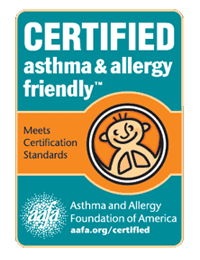During the third week of National Healthy Homes Month, the Asthma and Allergy Foundation of America (AAFA) is recognizing the role of public health in healthy homes. Where a person lives and the quality and safety of their housing are connected to a wide range of health outcomes.
Social determinants of health (SDOH) are factors that influence a person’s health. They are the conditions in the environments where people are born, live, learn, work, play, worship, and age. They can affect a wide range of health, functioning, and quality of life outcomes and risks.1
Housing-related health issues, such as asthma, cost our health care system and society an estimated $53 billion each year.2 Home environments, such as mold, poor indoor air quality, and pests, contribute to about 20 to 30% of asthma cases.
The quality of housing is a major factor in asthma disparities in the United States. Families living in low-income housing are more likely to be exposed to harmful asthma triggers and are at a greater risk of having severe asthma. These families often lack the resources to address health issues in the home.
Week 3 of National Healthy Homes Month focuses on solving public health challenges with healthy homes solutions. As part of AAFA’s Health Equity Advancement and Leadership (HEAL) program, we are supporting local community-based interventions to address inequities in asthma and allergic diseases. The local programs work with people with asthma to teach them about how the home environment affects asthma control.
Community health workers and asthma educators complete home environmental assessments to help find and reduce asthma triggers while teaching people in the home about asthma management. They get resources for services such as integrated pest management (IPM) or housing repairs.
 The household also receives CERTIFIED asthma & allergy friendly® products that were donated to the HEAL program sites. These products can help reduce indoor asthma and allergy triggers and contribute to healthier indoor environments. They have been tested to meet strict scientific standards. If they pass all tests, they earn our asthma & allergy friendly® certification mark.
The household also receives CERTIFIED asthma & allergy friendly® products that were donated to the HEAL program sites. These products can help reduce indoor asthma and allergy triggers and contribute to healthier indoor environments. They have been tested to meet strict scientific standards. If they pass all tests, they earn our asthma & allergy friendly® certification mark.
Government agencies and other organizations offer information and assistance to help people improve their home environment. Here are some resources to help people living with asthma make their home healthier:
- HOME Allergy Management
This online tool by the American College of Allergy, Asthma, and Immunology (ACAAI) educates people with allergies on managing indoor allergens. With HOME, a person can learn about the different types of indoor air allergens and receive tips on managing allergies. - 10 Steps to Making Your Home Asthma Friendly
The Environmental Protection Agency (EPA) provides 10 steps to help get rid of allergens in the home and have a more asthma-friendly home. - Help Your Child Gain Control Over Asthma
This booklet from the EPA helps parents learn more about how to prevent their child’s asthma attacks. It describes how to create a plan to take control of asthma and ways to find and keep things that could trigger an asthma attack away from a child. - Your Local 211
Supported by United Way, 211 is a comprehensive source of information about local resources and services. Call 211 or use their online search tool by location for resources and contact information. - Low Income Home Energy Assistance Program (LIHEAP)
LIHEAP helps keep families safe and healthy through initiatives that assist families with energy costs. LIHEAP provides federally funded assistance to reduce the costs associated with home energy bills, energy crises, weatherization, and minor energy-related home repairs. This webpage provides a map by state/territory of LIHEAP administrator contact information and website. - Low Income Household Water Assistance Program (LIHWAP)
LIHWAP helps low-income households pay their water and wastewater bills to prevent shutoffs or restore services. This webpage provides a map by state/territory of contact information for LIHWAP administrators.
Find more resources on our Healthy Settings webpage under “Healthy Housing.
Looking for more ways to make your home healthier and reduce your exposure to asthma and allergy triggers? Join our community to get more information and talk with others about how you can have a healthier home.
JOIN NOW
References
1. Office of Disease Prevention and Health Promotion. (2023). Social Determinants of Health. Healthy People 2030; U.S. Department of Health and Human Services. https://health.gov/healthypeop...-determinants-health
2. National Healthy Homes Month Themes and Content June 5, 2023 - June 30, 2023. (n.d.). U.S. Department of Housing and Urban Development. Retrieved June 20, 2023, from https://www.hud.gov/program_of...thy_homes/nhhmthemes

Comments (0)